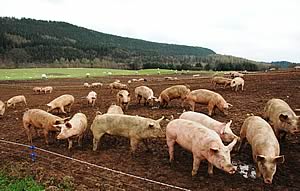 |
|||||||||
|
|||||||||||||||||||
|
|
NADIS
Pig Health Report for October 2007 16/11/07 A common theme in anecdotal reports by NADIS veterinary surgeons in the early part of the month were problems that have accrued as a result of restrictions of movements of pigs under the FMD controls and the indirect effect of the ban on export of meat reducing demand for both clean pigs and sows. With restrictions now relaxing it would be anticipated that on farm problems will subside.
Adults Sow mortality was highlighted by a number of reporters as increasing and in many cases this has been a direct result of having to retain cull sows due to market restrictions. Either sows have been euthanased because they have not been able to be sold or the overcrowding resulting from retention of cull sows leads to injury requiring euthanasia or direct deaths. A number of reporters have also commented that seasonal infertility has not been a major problem and generally at much lower levels than is usually the case. This may have implications late in the year if excess numbers have been served to offset the anticipated dip in fertility. Notwithstanding, these general observations, sporadic reports of extended weaning to service intervals, late drop outs and even abortions have been received although the latter are generally within ‘normal’ limits and probably do not represent specific seasonal problems. Lactation failure due to overfeeding of sows around farrowing time was observed, details of which are available in an earlier health bulletin. Infectious disease was a very limited problem during October, although reports of Erysipelas (despite vaccination) and presumed Swine Influenza were received.
Piglets As well as the usual scour reports involving E.coli, coccidia etc, the most important issue discussed related to overproduction of piglets either as a result of very high litter size or due to excessive numbers of sows farrowing, requiring distribution of piglets amongst remaining sows. Given that sows only produce a finite amount of milk, if this has to be shared between more piglets then growth will suffer in individuals with an impact on weaning weight and post weaning performance. Tail docking, whilst not permitted to be done routinely is nevertheless necessarily widely practiced. However, if not done cleanly or with excessive heat, damage to the tail base can be significant and this was noted in one report.
Weaners In the immediate post weaning period, problems identified in the month included E.coli scour, meningitis and fading piglets as a result of weaning too small where growth on the sow was compromised. PMWS was prevalent in the older weaners with its common complication of Glassers Disease frequently reported. Ear tip necrosis was also widely seen but the most common features within weaner buildings commented upon, particularly in the early part of the month, were disruption to pig flow and overcrowding as a result of movement restrictions and the knock on effects of reduced demand for finishing pigs. Fly bite lesions were reported in young yarded pigs in a single farm and it is hoped and expected that this problem, which has been seen sporadically throughout the summer, will now abate.
Finishers Scour/looseness in growing pigs remains a major issue with Ileitis, Colitis and Swine Dysentery continuing to feature variably as specific causes. However, the most noticeable feature of the last month is a general observation by a number of reporters that loose faeces is widespread since new season grain has come into use. As with fly bites, it would be expected that this would decline. Influenza continues to appear sporadically amongst problems of mixed respiratory disease, as a clinical diagnosis. This virus is rarely isolated by the VLA at the moment but this may reflect on unwillingness on the part of producers to pay for diagnostic testing. (Recent restrictions on sample submission may also have played a part.) Damage to pigs was reported in a range of formats:
Wasted pigs, in some cases in association with PDNS, were sporadically reported with a least one instance of what used to be called “arable disease” i.e. neglect of the normal standards of care as a result of distractions of land work. A final observation from clinicians undertaking abattoir monitoring is the increase in overt cases of pregnancy in slaughter gilts with 4 – 5 week gestations reported. Whilst such cases frequently are seen sporadically an increase may represent simply the fact that pigs have been ‘rolled over’ for slaughter and many will be 1 – 2 weeks older than usually is the case. As we settle into the winter, problems to watch out for include:
Mark White BVSc DPM MRCVS
|
||||||||||||||||||

|
|
||||||||||||||||||
| home | agri-services | pedigree
pen | news | dairy | beef | machinery property | organisations | site map |
|||||||||||||||||||

